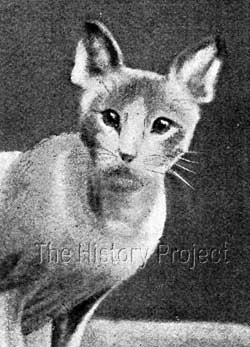 | ||||||||||||||||








 |
NELLIE (c1895)
| |||||||||||||||
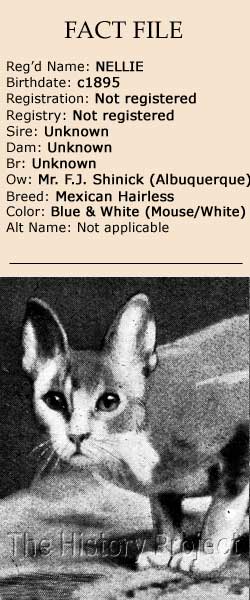 |
|
Courtesy of The Harrison Weir Collection |
HISTORICAL BACKGROUND:
In the case of the modern day Sphynx, the apparent hairlessness is the result of a recessive mutation. The Sphynx of today are descended from a mix of two lines of naturally occurring mutations, one from a domestic cat in Toronto, and the other from a family of barn-cats, in Minnesota. The descendants of both these foundation lines, (generally referred to as the Canadian Sphynx) , were notionally outcrossed to Devon Rex lines in an attempt to expand the gene pool, and the resulting offspring were the basis and early foundation for the Championship breed, so popular now in all corners of the globe.
The 'Mexican Hairless' cat, certainly resembles a Sphynx and we have no reason to believe that its occurrence was any different, and therefore, likewise, it could just as easily have been the result of a naturally occurring mutation in a domestic population. However, because none of these original cats survived, or were successfully bred from to our knowledge, we can never know whether their gene for hairlessness was in fact a recessive one; or whether, such as in the case of the Don Sphynx found in Russia, a dominant one.
Certainly, the appearance of 'The Mexican Hairless' cat in the late nineteenth century caused quite a sensation. The widely known photograph of 'Nellie' and 'Dick', which was published in an excellent full page format, in the The Book of The Cat (1903), alongside both the article by Mr. H. C. Brooke and the letter contained from Mr. F. J. Shinick of New Mexico, has certainly become iconic.
But this was not the first time that this photo had been published, nor the second, and the writer has every reason to believe that this wonderful image, may have been obtained through the connections and labour of other well-known cat fanciers.
PARENTAGE & OWNERSHIP:
Unknown
Unknown
| Unknown
Nellie, c1895, Blue/White Mexican Hairless, F
| Unknown
Unknown
Unknown
Although parentage can never be established, 'Nellie' and her companion 'Dick' were at the time the article was written, in the ownership of Mr Shinick, who had so kindly written the below letter in answer to Mr H. C. Brooke's initial enquiries about the new breed:
Albuquerque, New Mexico,
February 3rd, 1903Mr. H. C. Brooke,
Dear Sir, - Yours of January 20th is at hand. In answer would say my hairless cats are brother and sister. I got them from the Indians a few miles from this place. The old Jesuit Fathers tell me they are the last of the Aztec breed known only in New Mexico. I have found them the most intelligent and affectionate family pets I have ever met in the cat line; they are the quickest in action, and smartest cats I have ever seen. They are fond of a warm bath, and love to sleep under the clothes at night with our little girl. They seem to understand nearly everything that is said to them; but I have never had time to train them.
Detail showing 'Dick Shinick'
Photo: The Book of The Cat (1903)1
Image courtesy of The Harrison Weir CollectionThey are marked exactly alike - with mouse-coloured backs; with neck, stomach, and legs a delicate flesh tint. Their bodies are always warm and soft as a child's. They love to be fondled and caressed, and are very playful; will run up and down your body and around your waist like a flash. Nellie weighs about eight pounds and Dick weighed about ten pounds; but I am sorry to say we have lost 'Dick'. We have never allowed them to go out of the house, as the dogs would be after them. They were very fond of our water spaniel and would sleep with her. 'Dick' was a sly rascal, and would steal out, one night last year, he stole out and the dogs finished him. His loss was very great, as I may never replace him.
The Chicago Cat Club valued them at $1,000 each. They were very anxious for me to come on with them for their cat shows, but I could not go. They were never on exhibition; as this is a small city, I feared they would be stolen. I have made every endeavour to get another mate for 'Nellie', but have not been successful. I never allowed them to mate, as they were brother and sister, and I thought it might alter 'Nellie's' beautiful form, which is round and handsome, with body rather long. In winter they have a light fur on back and ridge of tail, which falls off in warm weather. They stand the cold weather same as other cats. They are not like the hairless dogs, whose hide is solid and tough; they are soft and delicate, with very loose skin.
'Nellie' has a very small head, large amber eyes, extra long moustache and eyebrows; her voice now is a good baritone, when young it sounded exactly like a child's. They have great appetites and are quite dainty eaters - fried chicken and good steak is their choice. Have never been sick an hour. The enclosed faded picture is the only one I have at present; it is very lifelike, as it shows the wrinkles in its fine, soft skin. 'Dick' was a very powerful cat; could whip any dog alone; his courage, no doubt, was the cause of his death. He always was the boss over our dogs. I have priced 'Nellie' at 300 dollars. She is too valuable a pet for me to keep in a small town. Many wealthy ladies would value her for her weight in gold if they knew what a rare pet she is. I think in your position she would be a very good investment to exhibit at cat shows and other select events, as she doubtless is the only hairless cat now known. I have written to Old Mexico and all over the country without finding another. I would like to have her in some large museum, where she would interest and be appreciated by thousands of people.
Trusting this will reach you in safety,
I am very truly yours,
F J SHINICK.1
From this letter, we find that 'Nellie' had a normal home life, sharing a bed with a child, or the pet water spaniel! As to her colour and pattern it is likely that she and Dick were Blue Bi-Colours, taking into account both the description and the photograph.
SIBLINGS & SHOWS:
But it seems probable that 'Nellie' and 'Dick' were indeed shown...not in Albuquerque, "for fear of being stolen" and Mr. Shinicks letter is certainly open to interpretation when he states that "they were very anxious for me to come on with them for their cat shows, but I could not go." This could equally mean that arrangements had been made for them to be shown, but that Mr Shinick could not find the time to travel with them.
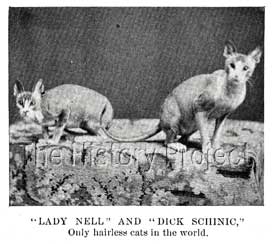 |
|
Image courtesy of The Harrison Weir Collection |
In an article written by Jennie Van Allen, about the recent 'Chicago Cat Club Show', for the 14th December issue of Harper's Bazar, there is a lengthy discourse on the exhibits on display at the First Regiment Armory, between the 7th and 10th of December 1898. Among the many named cats from all corners of the United States, are listed both 'Lady Nell' and 'Dick Schinic' who are described as "the only hairless cats in Christendom!" in the text, and "the only hairless cats in the world" in the caption to their photo.
This would suggest that the cats were shipped to Chicago for the big Show (the very first Cat Show to be held in Chicago). I am of the opinion that this is possibly where the famous photo of "Nell and Dick' may have been taken, as the publication of this photo (which is the same image), predates the publication of it in both Helen Winslow's book, Concerning Cats in 1900, and the subsequent publication of it again, in Frances Simpson's The Book of The Cat in 1903. Mrs. Leland Norton was the President of the Club at this time, and would certainly have been in a position to have the press come to her home in Drexel Boulevard to have the photo taken in a studio environment. The show was also supported by a large number of wealthy patronesses who between them could have easily arranged for the safe passage of the cats. And where did the $1,000 suggested valuation of the cats come from? The Chicago Cat Club. A copy of the excellent (not faded) image we see today, would then have found its way into the hands of Mr. H.C. Brooke, who eventually passed it on to Cassell's for inclusion in The Book of The Cat.
BREEDING & PROGENY:
Obviously there are no records of 'Nellie' ever having been bred. But the mystery does not stop there. From Mr Shinick's letter to Mr Brooke, we know that 'Dick' died in the preceding year, hence in 1901. If we accept that at best, the cats were indeed in Chicago for the Show of late 1898, or presume at worst, the photo which was used in the article published on that date was authentic, then judging by the maturity of 'Dick' in that photo, we may fairly assume that he was already probably two or three years old when the photo was taken. This puts his date of birth, and probably 'Nellie's' at around 1895 and probably not later than 1896.
PHOTOS:
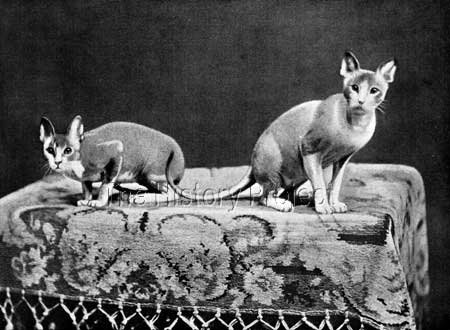 |
|
Courtesy of The Harrison Weir Collection |
SOCIAL MEDIA :
But the mystery does not end there. These were supposed to be the only Mexican Hairless cats in the world were they not? Yet, in Charles H. Lane's book, also published in 1903, he includes an illustration by artist Rosa Bebb, of another Mexican Hairless cat, a female named 'Jesuit'. In his brief article on it, he states:
"I believe the above-named (referring to the Mexican Hairless) and following varieties of cats have not been mentioned or illustrated in any previous work on domestic cats, nor do I remember seeing more than one specimen of the former exhibited in this country, but I hope it may prove they are not quite extinct, as they are different from any other variety with which the writer is acquainted, and so rare as to be exceedingly valuable to all students of natural history, irrespective of their interest to cat lovers.
"The illustration is of a portrait of the one belonging to the Hon. Mrs McLaren Morrison, the only specimen I have seen shown in this country."4
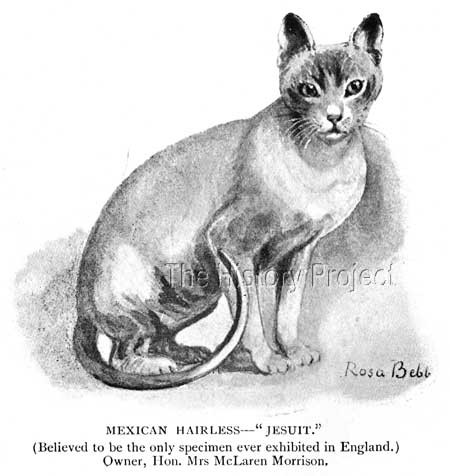 |
|
Illustration by Rosa Bebb, from Rabbits, Cats and Cavies (1903)4 Courtesy of The Harrison Weir Collection |
So this now begs the question... was the very connected and industrious pioneering importer of all things exotic, Mrs. McLaren Morrison, successful where Mr. Shinick was not? or perhaps, did she in fact buy 'Nellie' from him? And have her shipped to England? Is it possible that 'Nellie' ended her days at Kepwick Park in Yorkshire?
And if she did, if only Mrs. Morrison had bred her to a domestic and then bred in, by breeding a male back to her, she may have then unwittingly discovered that coated progeny could carry the ability to throw hairless kittens. Ah! What might have been!
In summary, although the unique Mexican Hairless mutation appears to have died out, others did follow. In a 1956 issue of Cats Magazine the well-known breeder Virginia Cobb of Newton cattery (USA) published a photo of a bi-colour Mexican Hairless kitten named "Friskey" who was born in a normal litter and was owned by a Loren Hanson of Hillsboro, New Hampshire. He apparently appeared in the 1931 Boston Cat Show!3
 |
|
Photo: Loren Hanson. 'CATS Magazine', November, 1956 3 Courtesy of The CFA Foundation |
Another instance, was reported by none other than renown Australian judge Fred W. Pearce, in the March 1960 issue of Our Cats, with the article supported by two excellent photographs of the 'nude' cat. It appears to be a black and white hairless mother cat playing with her normal coated tabby and white kitten. The owner of the cat was Mr. Rigby Warren, of Longwarrin, Victoria, whose female cat was named 'Sylvester'. From a subsequent interview it was determined that she had been born in December 1955.2
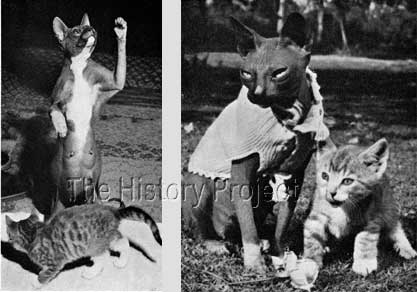 |
|
Photos: R. Daley. For 'Our Cats' March 19602 Courtesy of The CFA Foundation |
Of one thing we can be sure, that although 'Nellie' and 'Dick' are long gone, their legacy of wonder about the possibilities that come with natural mutations is sure to keep the cat fancy alight for many generations to come.
REFERENCES:
- Article by H.C. Brooke, The Book of The Cat by Frances Simpson, 1903
- Our Cats, March 1960 (Photos by R. Daley)
- Cats Magazine, November 1956 (Photo by L. Hanson)
- Rabbits, Cats and Cavies by Charles H. Lane, 1903
- Harper's Bazar, 14th December, 1898
- Photos and quotations as per sources quoted.
Registers associated with this article include The Incorporated Cat Fanciers Association of Great Britain (TICFAGB), National Cat Club (NCC), The Cat Club (CCR), Beresford Cat Club (BCC), Feline Federation Francaise (FFF), Siamese Cat Registry (SCR), US Register & Studbook for Cats (USR)including Supplement(USRS), The Studbook of the American Cat Association (ACA), and the Studbook & Register of the Cat Fanciers' Association (CFA).
Home | Cats | Gallery | Clubs | People | Artifacts | Articles | Updates | Contact Us
©The CFA Foundation, Inc and The Harrison Weir Collection
This project is a collaboration between The CFA Foundation, Inc. and The Harrison Weir Collection.
All material on this site is copyrighted and may not be printed or reproduced, in any form, without the express written consent of the collaborators.
